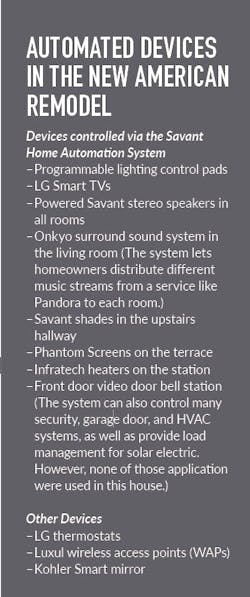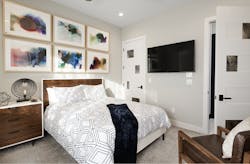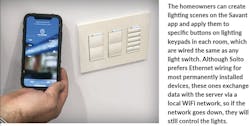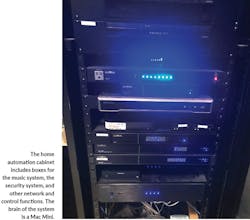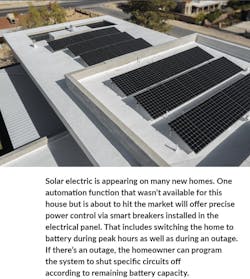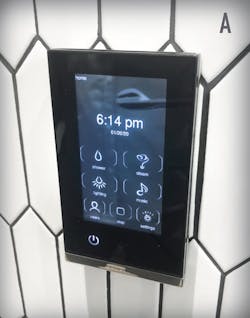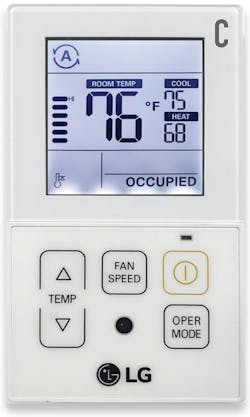Soito has been in the business since 2004, and he’s seen enormous changes in home building and remodeling through his career. Today’s homes often come standard with sophisticated devices, automation, voice and touch controls, and a new generation of homeowners brought up on technology.
Professional Remodeler sat down with him to discuss how builders and remodelers can respond to these trends.
Pro Remodeler (PR): What does future proofing look like in a wireless world?
Rob Soito (RS): In some ways it’s simpler than before. In other ways it’s more complicated.
What’s simpler is that you no longer need to run wires for every potential device. If budgets are tight, wireless devices can be added later. Video doorbells, smart thermostats and other gadgets can be all be installed by a handy homeowner. So can wireless speakers (though hardwired ones sound better). You can even get battery-powered automated shades.
For security, I prefer wired cameras for their reliability, but some people prefer to hire a security company to add a wireless system after they move in.
A good integrator knows what has to be wired and what should be wired for best results. The integrator can also help homeowners sort through privacy and convenience issues, like the pros and cons of storing personal videos on a “cloud service” versus a local, in-house device.
PR: Are young people better home automation customers?
RS: While they want to hear all the options, as a group they’re very budget-conscious. Having grown up with technology, however, many are comfortable installing and configuring electronic gadgets. This is the DIY route, and is generally offered by companies that sell devices that store data on cloud-based services, like those increasingly popular voice controllers.
Although the New American Remodel has a lot of technology hidden its walls, lights, televisions, the sound system, and even the ceiling heaters and Savant shades in the outdoor terrace can all be controlled via a home automation app.
PR: Where do you still need wiring?
RS: This is where it gets complicated. You will always get more reliability from a hardwired device, and certain things absolutely need wiring.
Every home gets TV wiring. We also like to put Ethernet jacks in various places—to accommodate computers and wall-mounted automation control screens. Most everyone will have a phone app, but wall-mounted devices provide another option and can also be used by guests.
As mentioned, I also prefer hardwired cameras. This house has ten four-megapixel security cameras, as well as a front-door station with camera. They’re remotely viewable via a phone app, but store data locally.
PR: Is that what’s called “structured wiring.”
RS: We still use that term, but what we’re installing today is different than the structured wiring of a decade or two ago.
Structured wire used to be defined as two coaxial cables and two Cat 5 cables wrapped in a single jacket. It was brought to locations where the homeowners wanted televisions or networked computers. In the old days, a 4,000+ square foot home like the New American Remodel might have two terminations per room, but today we run wires to more locations. There are three to five per room in this house; on other jobs the number depends on what the homeowners want.
However, the wiring varies by location. WAPS, security cameras, and wall-mounted controllers get power and data via a single Ethernet cable, which is called POE or Power Over Ethernet. So do powered stereo speakers—though I personally think conventional speakers sound better, and they only need 14-gauge speaker wire.
A TV location might get an HDMI cable and three Ethernet cables: one for delivering data to a smart TV; another for video sharing; and a third for control signals or as a backup. We also still bring coax to TV locations in case the homeowners opt for basic satellite or cable.
PR: How does cost compare to traditional structured wiring?
RS: Today, a new wiring package in a house of this size would be $7,000 to $10,000 installed. That’s compared to $4,000 to $6,000 for old-style structured wiring.
PR: Can you tell me about the home automation system?
RS: We used the Savant system in this home. There’s a server cabinet in the home’s mechanical room that controls a variety of devices throughout the house. We also used Savant’s smart light switches, which the homeowner can program via a handheld app.
PR: What other value does the integrator offer?
RS: There’s really no plug-and-play with digital systems. Everything is run by software, which needs to be set up and configured. We do all of that, and we don’t consider a job finished until everything works seamlessly.
When advising the homeowner, we have to fulfill as many of their needs as possible within the budget. But we also need to open their eyes to other possibilities.
The ethernet cable we use is CAT 6. The copper wire is slightly thicker and more tightly wound than in CAT 5.
The conversation usually starts with a question like, ”Do you like the concept of home automation?” Most people ask what we mean, which is an opportunity to present options they might not have considered: automated blinds, automated lighting, and the ability to control nearly every electronic device in the home with a single app. Next, we discuss the functions they want in each part of the house. For instance, some parents want the ability to kill WiFi in the kids’ rooms at certain times.
We use this information to create a blueprint that lists all the devices the home will have and how the automation system will control each one. We review that with the homeowner before writing specs and drawing up a contract.
PR: Do you see trends in homeowners’ tech priorities?
RS: Our biggest current demand is for entertainment. Most high-end homeowners want a home theater room. It doesn’t have to be a separate space, however; the living room in this house serves that purpose.
Other popular options include security cameras and door locks that can be monitored from a phone, thermostats with the ability to control different zones, and automated shades. After that it depends on the homeowner, but we make it clear that the automation system can control a wide variety of things, from the irrigation system, to the pool lights, to the exterior gate.
PR: How practical is it to retrofit digital wiring to an existing home?
RS: If you’re not opening up the walls, you spend a lot of time fishing wires through stud bays and across attics and basements. However, I’ve retrofitted all the functions you see in the New American Remodel to plenty of older homes.
The bottom line is that there’s a real case to be made for future proofing. There are homes that I roughed in for speakers 15 years ago. Then the house sold and the new owners called me and asked me to come back and install speakers and hook up those wires.
As one would expect of a smart home, TNAR has a number of wireless and wired control interfaces. Three examples:
A. Kohler’s wall-mounted remote lets someone using the shower control water
as well as sound (which is provided by Kohler speakers embedded in the tile).
B. The Savant home automation system
makes its interface available on a wall-mounted, hardwired controllers
(shown here) as well as a handheld app.
C. LG’s Simple Remote Controller provides
an interface for monitoring and control of
a group of indoor units serving single zone.
About the Author
Charlie Wardell
Charlie Wardell is a freelance writer and former remodeler in Tisbury, Mass.

